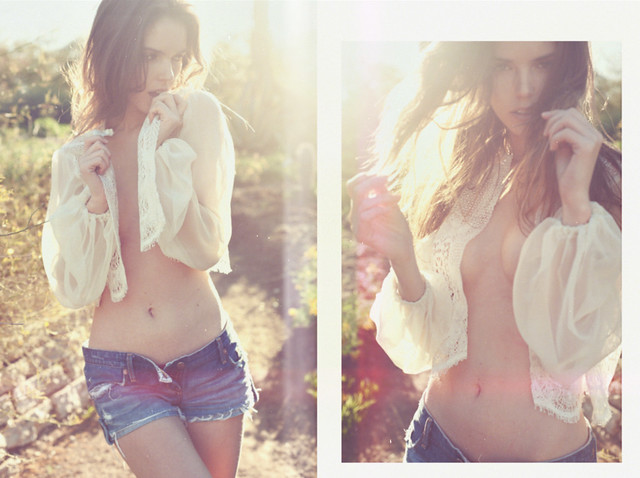
Wildflower.
In response/followup to an outdoor workshop I did last week!
I'm very pleased the sun decided to make an appearance so we could practice our lifestyle-esque photography with Jessica and Kat and Tiffani. I think you demonstrated good control of the camera with regards to shooting with and against the sun. Here are some parting thoughts that I feel can help you along the way in getting from 7+ to 10 (in terms of comfort with shooting outdoors).
- Love the blinkies. I love my blinking highlights. It's a quick way to tell me what detail I've lost. The question then becomes, "Did I lose anything important?" If it's some sky detail, or some blown out sand, then no. But if it's skin detail or some texture in the wardrobe, then yes. The question then becomes...
- "How do I get that detail back?" If that detail is important and there is a big discrepancy between your blown highlights and your subject, it's time to balance the exposure between your highlights and your subject. Usually the blown highlights result from direct sunlight. So you have 2 options: 1) Kill the direct sunlight e.g. use a scrim, like when I held the 2 stop scrim at the river above Jessica's head to reduce the blotchiness of sunlight on her face or 2) Increase the subject's exposure e.g. reflect light onto your subject so you can drop the exposure on the overall image. As your image has less dynamic range, you can expose closer for the highlights without losing shadow detail and allowing you to retrieve some of the blown highlight detail.
Or hell, do both (scrim and reflect).
And if all else fails you can always overpower the sun with a strobe. But as we discussed, that yields an entirely different look and often is a slippery slope to overpowering the sun too much!
- Read that histogram. The histogram is full of valuable information. The shape, the skew, the clustering, they all tell you important detail about what your sensor is "seeing". Translating that graphical information into knowledge is key. For example, when you see that there's truncated data towards the right, you know you have lots of information that lies outside the 255 (white) point that your sensor is not capturing. Another example is that when you see no data between 0 and 100 you know that you could potentially use a lesser exposure in the event you've blown some highlights. Because you have room to spare on the bottom end. So love that histogram! It's your friend!
- Birds of "feather" flock together. If you can bribe someone to come with you on your outdoor shoots you'll have someone to help you with reflectors, scrims, or even strobes. The best assistant is a makeup artist. He/she can not only do makeup but also help you with lighting.
- Feathering. Speaking of feathers, never hit your model with the full force of the blinding sun via reflected light. It's too harsh and remember that models with lighter colored eyes tend to be more prone to squinting. So feather feather feather. Feathering softens the brunt of the reflected light so it's more even and softer and better balanced with the background! It's a learned art and hopefully your assistant has some experience with the reflector. Otherwise you're not only going to be dealing with hot spots but you'll also be dealing with a range of exposure on your images as your assistant looks for the light!
- Background control. I think you got much better at seeing what makes for a "good background". In the studio it's easy. Solid white/grey/etc. No big deal. Even exposure on the background is easy to achieve indoors. But outdoors you have no control over the landscape. The only control you have is your model's relative position to the landscape and your shooting position. So often it's a compromise. But you did a great job recognizing that maybe you need to shoot taller on her to reduce the blown sky highlights (when we were in that field). Or maybe you have to move her to a part of the field where there's more mountain in the background to cover the top portion of the image? Recognize and manipulate the background!
-Relative angles. Speaking of not being able to control the landscape, you can't control the sun either. But we have control over the model's relative angle to the sun and that's really the key isn't it? It doesn't matter if it's high noon. Lie the model flat on her back and shoot from above her and you'll have flat lighting. Positioning her relative to the sun intelligently to create the proper lighting angle whether it be Rembrandt, loupe, split, butterfly, etc. is the key!
So keep shooting! I'm very proud of your progress throughout the day and being able to shoot that last outfit without my assistance. Go out there when you get the chance! google "Morris Reservoir" for the road we were on and you'll find all the places we shot at.
I'm looking forward to doing the Magic workshop with you as a private session. If you'd like you can read up on Magic on my blog by simply entering "Magic" into the search box on the right. I think I have at least 6 articles written on the subject that will really prep you for our session! In addition, I'm really looking forward to the "problem-solving" portion of retouching where we go through several images and tackle the "issues/challenges" :) I really enjoy the problem-solving process and I think you'll find that my approach is very logical and will help you see the existing problems. Hopefully this translates into foreseeing future problems during capture!
And as always you're very welcome to ask me anything anytime! I'm hoping to be a part of your photographic journey going forward! :)

No comments:
Post a Comment